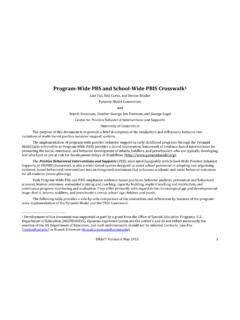Transcription of School-Wide Positive Behavioral Interventions and Supports
1 School-Wide Positive Behavioral Interventions and Supports Jose Hernandez, , , NCSP Director of Early Childhood/IDEA Follow us on FB and/or Twitter #OKSPED Alignment to Learning Forward Standards The new education law, Every Student Succeeds Act (ESSA), redefines professional development with a purposeful influence from Learning Forward. Learning Forward, a national association recognized as leaders in professional learning, has established standards for professional learning that set a high bar for quality learning experiences. This session aligns to the following standard(s): Learning Communities: Committed to continuous improvement, collective responsibility, and goal alignment. Leadership: Develop capacity, advocate, and create support systems. Resources: Coordinating Resources. Implementation: Sustaining support for implementation of professional learning. Teaching Expected Behavior If a child doesn t know how to read, we teach.
2 If a child doesn t know how to swim, we teach. If a child doesn t know how to multiply, we teach. If a child doesn t know how to drive, we teach. If a child doesn t know how to behave, we ..teach? ..punish? Why can t we finish the last sentence as automatically as we do the others? T. Herner, 1998. Let s Play the Blame Game When the child misbehaves, whose fault is it? it When the child misbehaves, what can educators change? home life parents school environment/climate Is behavior a problem? One of the earliest education text was on classroom management (1907) Opinion polls rank behavior problems as the major issue in schools Teaching students how to behave Why teach? We teach because it works. We teach social behavior skills because we know there is a close connection between academic and social competence (Algozzine, Wang, & Olivette, 2011). Behavior should be taught as a lesson or lessons Define terms Discuss rationales Provide examples Tell Show Do Myths about behavior and behavior management Let s examine some myths and make our own decisions Myth 1: Use of Reinforcement to change behavior is bribery.
3 Bribery = the practice of offering something (usually money) in order to gain an illicit advantage Typically has an illegal or illicit intent The reward is provided before the behavior Reinforcement Behaviors are typically agreed upon Reinforcement is delivered after the behavior Myth 2: Children should work for intrinsic rewards. Very few if any behavior is intrinsically reinforced Even if we are unaware of it, most of what we do is the result of external reinforcement Even if you believe the above statement, it is a futile way to approach things, So what do you do if a child is not intrinsically reinforced to do/learn something? Ask yourself, would you come to work for free? Behavior can be a problem. We can choose to admire the problem or act. The first action should is to be proactive not reactive. The Magic Ratio 5-to-1 ratio is a practice in which teachers increase the number of Positive interactions with students as compared to negative interactions.
4 Research has supported the idea that there is a critical ratio of Positive to negative interactions between teachers and students to best support and sustain constructive student-teacher relationships. That ratio is to provide 5 Positive interactions ( friendly conversation, nonverbal acknowledgement, praise, and so forth) to every 1 negative interaction ( punishment, criticism, and so forth) for each student. What is PBIS? PBIS is a framework that helps school personnel to adopt and organize evidence-based Behavioral Interventions and utilize the those Interventions to enhance academic and social behavior outcomes for all students. Based on the basic principles of behavior A prevention-oriented way for school personnel to: (a) organize evidence-based practices; (b) improve their implementation of those practices; and (c) maximize academic and social behavior outcomes for students.
5 Why is PBIS Essential? Implementing the Tier I PBIS framework leads to improvements in: Problem disciplinary behavior; school climate; Student bullying behavior and peer victimization; and Academic Achievement. Bradshaw, Koth, Bevans, Ialongo, & Leaf, 2008; Bradshaw, Koth, Thornton, & Leaf, 2009; Bradshaw, Mitchell, & Leaf, 2010; Bradshaw, Reinke, Brown, Bevans, & Leaf, 2008; Horner et al., 2009; Horner, Sugai, & Anderson, 2010; Luiselli, Putnam, & Sunderland, 2002; Muscott, Mann, & LeBrun, 2008; Nelson et al., 2009; Pas, Bradshaw, & Mitchell, 2011; Sadler & Sugai, 2009; Simonsen et al., 2011; Simonsen, Fairbanks, Briesch, Myers, & Sugai, 2008; Waasdorp, Bradshaw, & Leaf, in press). (Mayer, 1995, Mayer & Sulzar-Azaroff, 1991, Skiba & Peterson, 1999) Framework of PBIS Positive Behavior Intervention Supports Tier I - Universal Tier II Targeted Tier III Individualized Tier I: The Universal Tier (80-90%) School-Wide implementation Preventative Targets all students, staff and settings Develops School-Wide expectations Reinforcement systems Behavior matrix Tier I PBIS Team Formation Example Tier I Team.
6 Teachers Administrators school Counselors school Psychologists Specialists Classified Staff Special Education Representation Tier I PBIS Implementation Define Expectations Staff meeting/Team time to brainstorm 3-5 clear and positively stated expectations Reflect traits/behaviors that staff value or that define the culture of the school Input from key stakeholders (parent groups, students, community members, etc.) Tier I PBIS Implementation Implement Expectations Once defined, communicate School-Wide expectations to students, parents, etc. Post expectations in key common areas of school and in every classroom Adults are the model of implementation Walk the talk Reinforcement Systems After expectations are taught, it is critical that expected behaviors are reinforced. Reinforcing a behavior increases the chance that the behavior will occur again and become a habit. Tickets, incentives, contests Make them relevant to age and interest!
7 Examples: Paw pride reinforcement Paw pride ticket Paw prides can be given to individual students or whole classes by any adult in the building Tier I Discipline school wide agreement on discipline systems and procedures school staff establish and agree on major and minor categories for problem behavior. Staff consistency in responding to problem behavior is key to effective disciplinary intervention and behavior change. Tools to define problem behaviors and agreeing on procedures to intervene. Tier I PBIS Data The PBIS team uses data to measure school climate, communicate successes, and target areas in need of improvement. Data tells you what is going well and what needs improvement. PBIS teams use data to drive school goals, Interventions , staff PD. Tier I PBIS Data Data systems you could use: school wide Information Systems (SWIS) ($$) GoogleSheets (Free) Microsoft Excel (Free) Behavior and Intervention Tracking Software (Free) Liveschool ($$) Hero App ($$) School-Wide PBIS Strategies School-Wide PBIS Strategies Gotchas or Caught you being good slips Student of the Month Widgets Gotchas A Gotcha is an individual recognition of a Positive behavior that the student displayed.
8 Gotchas can be given by any staff member. Gotchas are accumulated to earn rewards, which will be given individually and for an entire class. Student of the Month Nominations for the award are given by faculty and staff for an individual who demonstrates the characteristic of the month. A winner is chosen from each grade level and class. For example: Month of March: Respect Jose knows what respect is all about! He is always ready to help others in the classroom. He takes his classwork seriously and seems to always remember his manners by saying things like, thank you , sorry , or excuse me . Student of the Month Awards Certificates Pizza party at lunch with two friends Name recognition at assembly Just Dance with two friends Lunch with your teacher Letter to family Widgets Widgets are given to students who meet grade level expectations for reading or math. These widgets are hooked on their backpack and can be connected.
9 Widgets are awarded every 9 weeks Teachers hand out the widgets to the students who meet those expectations Linking Classroom Management to School-Wide Expectations and Systems Building the Link Classroom PBIS strategies are important tools to decrease disruptions, increase instructional time, and improve student social behavior and academic outcomes. Although individual teachers may implement PBIS in their own classrooms regardless of the broader school context, the effects of classroom PBIS strategies are maximized by (a) implementing within a School-Wide framework, like School-Wide PBIS; (b) directly linking classroom and School-Wide expectations and systems; (c) merging classroom PBIS strategies with effective instructional design, curriculum, and delivery; and (d) using classroom-based data to guide decision making. The Importance of Classroom Rules Classroom behavior management works for 85% of your students, 10% need more individualized intensive Interventions in the regular education classroom, and 5% need more intensive behavior Interventions including special education.
10 The extent to which the students know the rules and how to follow the rules is positively correlated with appropriate behavior. Rules should address safety, respect, and responsibility. Starting off the year with effective classroom management, including clear rules and procedures, results in higher levels of appropriate behavior and higher academic performance (Emmer et al., 1980, Evertson & Emmer, 1982). Guidelines for Rules Keep the number of rules to a minimum (3-5 rules per classroom). Convey expected behavior Age-appropriate Positively stated Teach-practice-reinforce Set an example for rule-following behavior Be consistent in enforcing the rules Keep rules posted where all children can see them BAMBOOZLED The first to answer the question correctly (raise your hand) is the winner of MARBLE JAR Classroom behavior management works for what percentage of your students?












